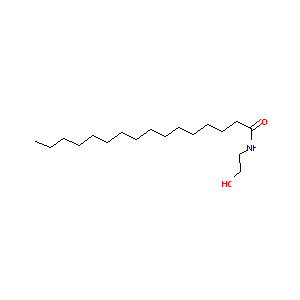Details of the Drug
General Information of Drug (ID: DMB1CZ8)
| Drug Name |
Guanfacine extended release
|
||||||||||||||||||||||
|---|---|---|---|---|---|---|---|---|---|---|---|---|---|---|---|---|---|---|---|---|---|---|---|
| Synonyms |
Palmitoylethanolamide; Palmidrol; 544-31-0; N-(2-Hydroxyethyl)hexadecanamide; Impulsin; Palmitamide MEA; Hydroxyethylpalmitamide; N-palmitoylethanolamine; N-(2-Hydroxyethyl)palmitamide; Palmitic acid monoethanolamide; Palmitoyl-EA; Loramine P 256; Palmitoyl ethanolamide; Palmidrolum; palmitylethanolamide; HEXADECANAMIDE, N-(2-HYDROXYETHYL)-; Palmidrol [INN]; Palmidrolum [INN-Latin]; UNII-6R8T1UDM3V; Palmitinsaeure-beta-hydroxyethylamid; Monoethanolamine palmitic acid amide; NSC 23320; hexadecanoyl ethanolamide; Anandamide (16:0)
|
||||||||||||||||||||||
| Indication |
|
||||||||||||||||||||||
| Drug Type |
Small molecular drug
|
||||||||||||||||||||||
| Structure |
 |
||||||||||||||||||||||
| 3D MOL | 2D MOL | ||||||||||||||||||||||
| #Ro5 Violations (Lipinski): 2 | Molecular Weight (mw) | 299.5 | |||||||||||||||||||||
| Logarithm of the Partition Coefficient (xlogp) | 6.2 | ||||||||||||||||||||||
| Rotatable Bond Count (rotbonds) | 16 | ||||||||||||||||||||||
| Hydrogen Bond Donor Count (hbonddonor) | 2 | ||||||||||||||||||||||
| Hydrogen Bond Acceptor Count (hbondacc) | 2 | ||||||||||||||||||||||
| Chemical Identifiers |
|
||||||||||||||||||||||
| Cross-matching ID | |||||||||||||||||||||||
Molecular Interaction Atlas of This Drug
 Drug Therapeutic Target (DTT) |
|
|||||||||||||||||||||||||||||||||||||||||||||||||||
|---|---|---|---|---|---|---|---|---|---|---|---|---|---|---|---|---|---|---|---|---|---|---|---|---|---|---|---|---|---|---|---|---|---|---|---|---|---|---|---|---|---|---|---|---|---|---|---|---|---|---|---|---|
 Drug Off-Target (DOT) |
|
|||||||||||||||||||||||||||||||||||||||||||||||||||
| Molecular Interaction Atlas (MIA) | ||||||||||||||||||||||||||||||||||||||||||||||||||||
Molecular Expression Atlas of This Drug
| The Studied Disease | Attention deficit hyperactivity disorder | |||||||||||||||||||||||
|---|---|---|---|---|---|---|---|---|---|---|---|---|---|---|---|---|---|---|---|---|---|---|---|---|
| ICD Disease Classification | 6A05.Z | |||||||||||||||||||||||
|
||||||||||||||||||||||||
| Molecular Expression Atlas (MEA) | ||||||||||||||||||||||||
References
